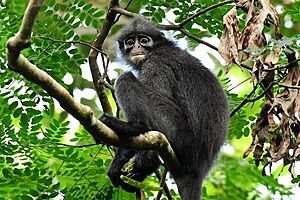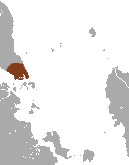Raffles' banded langur facts for kids
Quick facts for kids Raffles' banded langur |
|
|---|---|
 |
|
| Presbytis femoralis in Singapore | |
| Conservation status | |
| Scientific classification | |
| Genus: |
Presbytis
|
| Species: |
femoralis
|
 |
|
| Raffles' banded langur range in Singapore and Johor, Malaysia | |
The Raffles' banded langur (Presbytis femoralis), also known as the banded leaf monkey, is a type of monkey found only in Singapore and southern Peninsular Malaysia. It belongs to the primate family Cercopithecidae. Recently, scientists studied this langur more closely. They found that what was once thought to be one species is actually three different ones. This means the Raffles' banded langur is now considered critically endangered by the IUCN, mostly because it is losing its home.
Contents
About the Raffles' Banded Langur
The Raffles' banded langur is a medium-sized monkey. It measures about 43 to 61 centimeters (17 to 24 inches) long, not including its tail. Its tail is even longer, from 61 to 84 centimeters (24 to 33 inches). These monkeys weigh between 5.9 and 8.2 kilograms (13 to 18 pounds).
They have dark fur on their back and sides. A cool white band of fur crosses their chest and runs down the inside of their thighs.
Where They Live and How They Behave
Raffles' banded langurs are active during the day, which means they are diurnal. They spend most of their time in trees, making them arboreal. They love rainforests, especially those with tall trees. They don't come down to the ground very often.
These monkeys can live in different types of forests. This includes old, untouched forests and younger, regrowing forests. They also live in swamp forests and mangrove forests, and sometimes even in rubber plantations. They move around by walking on all fours and by leaping from branch to branch.
Langurs usually live in small groups. A wildlife researcher named Charles Francis noted that groups often have 3 to 6 monkeys. However, one study in Sumatra found larger groups, with an average of 11 monkeys. In these mixed-sex groups, there was usually one adult male for every five adult females. Each group used an area of about 22 hectares (about 54 acres) as their home.
Reproduction and Life Cycle
Raffles' banded langurs seem to have two main times of the year when babies are born. One is around June and July, and the other is in December and January. Studies have shown that many baby langurs survive past their first few months.
Baby langurs are born with white fur. They have a black stripe running down their back from head to tail. Another black stripe crosses their shoulders and goes down to their forearms. Young males leave their family group when they are about 4 years old, before they become adults.
Adult male langurs make a "ke-ke-ke" sound. When they are alarmed, they make a harsh rattling sound, followed by loud "chak-chak-chak-chak" calls. Sometimes, other monkeys like long-tailed macaques have been seen grooming the Raffles' banded langurs.
What They Eat
The Raffles' banded langur is mostly a vegetarian. It has special bacteria in its stomach that help it digest leaves and unripe fruit. One study found that almost 60% of their diet was fruits and seeds. About 30% was leaves, especially young ones.
Unlike some other monkeys, the banded langur destroys the seeds it eats. This means it doesn't help spread seeds around the forest.
Protecting the Raffles' Banded Langur
The IUCN officially listed the Raffles' banded langur as critically endangered in 2021. This is the highest risk category before extinction. There are only about 300 to 400 of these langurs left in the world. About 250 to 300 are in Malaysia, and only about 60 are in Singapore.
Because there are so few of them, and their homes are still being destroyed, they are in great danger.
Singapore Population
The Raffles' banded langur used to be common all over Singapore. But now, only about 60 individuals remain in the Central Catchment Nature Reserve. They used to live in the Bukit Timah Nature Reserve, but that group died out in 1987.
The number of langurs in Central Catchment dropped to as low as 10-15 monkeys. But it has slowly grown back to about 60 by 2019 and around 70 by 2022.
These langurs in Singapore eat from at least 27 different plant types. They seem to prefer certain fruits and will travel far to find them. Scientists are studying them to figure out the best ways to protect them. One study suggested that bringing some langurs from Malaysia to Singapore might help. This would increase the variety in their genes, which is important for their long-term survival. Singapore and Malaysia are now working together to protect these monkeys.
The biggest threat to the langurs in Singapore is losing their habitat. Most of Singapore's original forests are gone. The langurs live in small patches of forest that are not well connected. Hunting and the pet trade have also caused their numbers to drop. The Raffles' banded langur has been protected by law in Singapore since 1947.
The Singapore government is trying to help. They are developing Thomson Nature Park near the langurs' home. This will give the monkeys more forested area to use. They are also using rope bridges to help the monkeys move safely between forest patches. There's also a special wildlife bridge called the Eco-Link@BKE. The government hopes this bridge will help langurs return to Bukit Timah.
Sometimes, other types of monkeys, like dusky leaf monkeys, have been seen in Singapore. If more of these monkeys arrive, they might compete with the Raffles' banded langurs for food and space.


